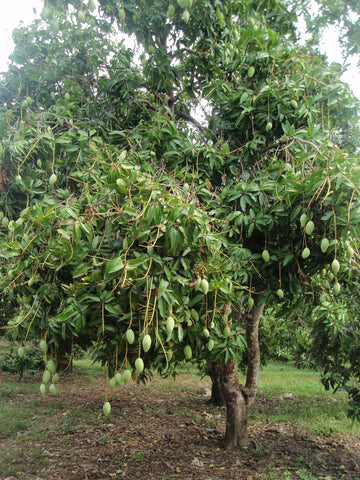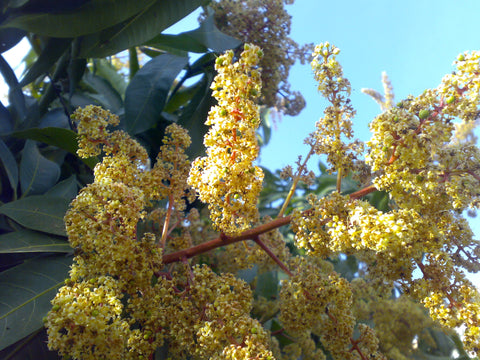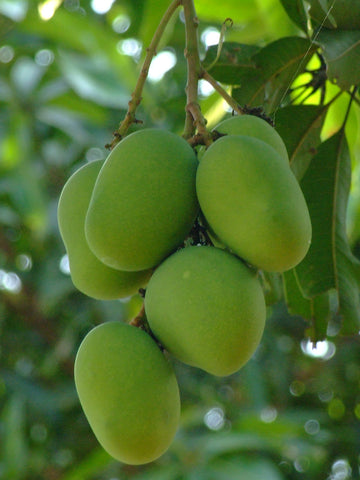+91 9493616161
+91 9493616161

Mango trees are tropical trees that are known for their sweet and juicy fruit. They belong to the flowering plant genus Mangifera, which is part of the Anacardiaceae family. Mango trees can grow up to 100 feet tall and can live for several decades. They are native to southern Asia, but are now grown in many tropical and subtropical regions around the world. The fruit is typically ripe during the summer months. Mango trees require a warm climate and well-draining soil to thrive. They also require plenty of sunlight and regular watering.

Mangoes are a delicious and nutritious fruit that can be grown in backyard gardens. They are a tropical fruit, so they require a warm climate and plenty of space to thrive. However, with the right care and attention, it is possible to grow a healthy and productive mango tree in your own backyard. This guide will provide an introduction to the basics of growing mango trees, including selecting the right variety, planting and caring for the tree, and protecting it from pests and diseases. Whether you're a beginner or an experienced gardener, this guide will provide the information you need to successfully grow a mango tree in your own backyard.

Growing mangoes in your backyard can be a rewarding experience, but it does require a certain level of care and attention. Here are some steps to help you successfully grow a mango tree in your backyard:
Choose the right variety: There are many different varieties of mango trees available, and some are better suited for backyard growing than others. Look for dwarf or semi-dwarf varieties that will stay smaller and easier to manage. Some popular varieties for backyard growing include 'Tommy Atkins', 'Ataulfo', 'Keitt' and 'Kent'.
Plant in the right location: Mango trees need full sun and well-drained soil. They also need protection from strong winds. Choose a spot in your yard that gets at least 8 hours of direct sunlight a day.
Water and fertilize regularly: Mango trees need to be watered regularly, especially during dry spells. They also need to be fertilized with a balanced fertilizer at least twice a year, once in the spring and again in the summer.
Prune to shape and size: Pruning is important to control the size of your tree and to encourage fruiting. Prune your tree every year or two to shape it and remove any dead or diseased branches.
Protect from pests and diseases: Common pests and diseases of mango trees include mango anthracnose, powdery mildew, and scales. Regularly inspecting and treating for these issues can help prevent damage to your tree.
Be patient: Mango trees can take several years to start fruiting, so be patient and enjoy the process of growing a tree in your backyard.
Harvesting: Mangoes are typically harvested when they have reached full maturity, typically from late spring to early summer. They should be harvested when they are fully ripe, with a slight give when gently pressed.

Caring for a Mangifera indica (mango) tree involves several key steps to ensure healthy growth and fruit production. Some of the most important things to keep in mind when caring for a mango tree include:
Planting: Mango trees should be planted in well-draining soil that is rich in organic matter. They also prefer a location that receives full sun.
Watering: Mango trees require regular watering, especially during dry periods. It's important not to over-water the tree as this can lead to root rot.
Fertilizing: Mango trees benefit from regular fertilization with a balanced fertilizer. This should be done during the growing season, typically spring and summer.
Pruning: Prune the mango tree to remove dead or diseased branches, and to shape the tree. This helps to promote healthy growth and fruit production.
Pest and Disease Control: Mango trees can be susceptible to pests such as mealybugs, scale insects, and fruit flies. Regularly inspecting the tree and using appropriate pesticides can help to control these pests. Additionally, mango trees can also be prone to fungal diseases such as powdery mildew, leaf spot, and anthracnose. It's important to keep an eye out for signs of disease and treat promptly.
Protection from frost: Mango trees are tropical plants and can't handle frost or cold weather. In areas where the temperature drops below 32°F (0°C) it's important to take measures to protect the tree.
Pollination: Most of the mango varieties are self-fertile, but planting two or more varieties can increase the yield.
It's also important to note that mango trees can take several years to reach maturity and begin to bear fruit. Patience and proper care are key to successfully growing a healthy mango tree.

Mangos are a popular fruit that are enjoyed by many people around the world. They are known for their sweet, juicy taste and are often used in a variety of culinary dishes, including salads, smoothies, and desserts.
Mangos are also a good source of various vitamins and minerals, including vitamin C, vitamin A, and potassium. They also contain antioxidants, which can help to protect the body against damage from free radicals.
In addition to their nutritional benefits, mangos have also been used for medicinal purposes in traditional medicine. The leaves of the mango tree have been used to treat various ailments, including diabetes and high blood pressure. The bark, leaves and the unripe fruit can also be used to make a decoction to treat fever.
However, it's worth noting that there is limited scientific research on the medicinal benefits of mangos and more research is needed to confirm their effectiveness.
Mangos can cause allergic reactions in some people, particularly those with a history of allergic reactions to other fruits such as birch pollen-related fruits like apples, cherries, apricots, etc.
Overall, mangos are a delicious and nutritious fruit that can be enjoyed as part of a healthy diet. However, it's always best to consult with a doctor or a qualified healthcare professional before using mangos for medicinal purposes.
In conclusion, Mangos are a tropical fruit that are enjoyed by many people around the world for their sweet and juicy taste. They are part of the flowering plant genus Mangifera, which is native to southern Asia. Mangos require a warm climate and well-draining soil to thrive and need to be properly care for. They are a good source of various vitamins and minerals and also contain antioxidants. They have been used for medicinal purposes in traditional medicine, but more research is needed to confirm their effectiveness. They can cause allergic reactions in some people, but are generally safe to consume as part of a healthy diet. It's always best to consult with a doctor or a qualified healthcare professional before using mangos for medicinal purposes.
Leave a comment